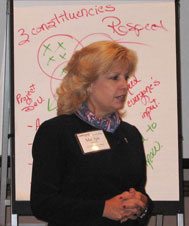
 |
The difference between delivering supportive services to the general population and serving a behavioral health population is the relationship of the services to the individual's recovery. For example, housing models like the Oxford House are structured to maximize substance abuse recovery. Residents in an Oxford House are expected to stay sober and are expelled if they are not. The houses build on the Alcoholics / Narcotics Anonymous recovery model, offering house members an opportunity to live in a drug/alcohol free environment. The rules of the Oxford House may not be applicable to a group living situation for people who are not in recovery. |
It is important to understand the nature of the illness your chosen population lives with. The philosophy your organization adopts with regard to the illness and the population will drive the way you deliver the service. Below is an example to illustrate how the philosophy of service can drive the delivery of supportive services:
An organization has decided to deliver a case management/care coordination service for adults with serious mental illness.
Medical Model |
Recovery Model |
|
| Name of Service | Case Management | Care or Service Coordination |
| Role of Professional Provider | Do what is best for the client | Involve the consumer in decisions about their care |
| Role of the Service Recipient | Comply with the decisions made on their behalf | Take responsibility for advocating and participating in their own care |
| How decisions are made about care | Professionals meet without the client present to decide what is best | Professionals, the consumer and those the consumer invites meet to discuss the options for care |
| Beliefs | • The client is impaired and does not understand what they need. • The client has something wrong with them that needs fixing by others. • The client won't recover. |
• The consumer can function in society with adequate support. • The consumer is the person with the most intimate knowledge of their own needs. • The consumer can recover. |
| Service Location | Office based - the client comes to the provider for service | Community based - the provider comes to the consumer - recovery can be fostered best in natural settings |
